数据结构算法经典 -顺序栈
头歌数据结构十大经典排序算法 -回复

头歌数据结构十大经典排序算法-回复什么是经典排序算法?经典排序算法是指在计算机科学领域中被广泛应用和研究的排序算法。
排序是计算机科学中的基本操作之一,它的目标是将一组元素按照某种特定的顺序进行排列。
经典排序算法通常被用来解决排序问题,可以应用于数据的排序、搜索、统计等各种计算任务中。
在这篇文章中,我们将讨论头歌数据结构中的十大经典排序算法,探索每个算法的原理和实现方法,以及它们的优缺点和适用场景。
1. 冒泡排序(Bubble sort)冒泡排序是一种简单直观的排序算法,它的基本思想是重复地交换相邻两个元素,将较大的元素逐渐“浮”到数组的尾部。
具体实现可以使用两层嵌套循环,外层循环控制比较的轮数,内层循环进行元素比较和交换。
冒泡排序的时间复杂度为O(n^2)。
2. 选择排序(Selection sort)选择排序是一种简单的选择最小元素的排序算法,它的基本思想是从头开始,逐个选择最小的元素,并将其放置到已排序部分的末尾。
具体实现可以使用两层嵌套循环,外层循环控制已排序部分的末尾位置,内层循环用于选择最小元素。
选择排序的时间复杂度为O(n^2)。
3. 插入排序(Insertion sort)插入排序是一种简单直观的排序算法,它的基本思想是将已排序部分的元素依次与未排序部分的元素进行比较并插入到正确的位置。
具体实现可以使用两层嵌套循环,外层循环控制未排序部分的元素,内层循环用于比较和插入元素。
插入排序的时间复杂度为O(n^2)。
4. 希尔排序(Shell sort)希尔排序是一种改进的插入排序算法,它的基本思想是将数组划分为若干个子序列,并分别对子序列进行插入排序,直到整个数组有序。
具体实现使用增量序列来控制子序列的划分和插入排序的间隔,最终将整个数组排序。
希尔排序的时间复杂度为O(nlogn)。
5. 归并排序(Merge sort)归并排序是一种分治法排序算法,它的基本思想是将数组分成两个子数组,分别对子数组进行递归排序,然后将排序好的子数组合并成一个有序的数组。
数据结构算法经典 -顺序表
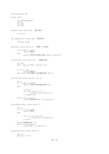
insertsort(struct sqlist *p,int n)
{
int i,j;
for(i=2;i<=n;i++)
{
p->sqlist[0]=p->sqlist[i];
j=i-1;
while(j>0 && p->sqlist[0]<p->sqlist[j])
printf("\n");
for(i=1;i<=n;i++)
printf("%d",p->sqlist[i]);
printf("\n");
}
}
display(struct sqlist *p)
{
int j;
if (p->size==0)
printf("此表为空无法显示!");
else
{
for (j=i;j<p->size;j++)
p->sqlist[j]=p->sqlist[j+1];
p->size--;
}
printf("此线性表为:");
for (i=1;i<=p->size;i++)
printf("%d->",p->sqlist[i]);
printf("%d",p->sqlist[j]);
}
}
main()
{
int i,select,a,j;int w;
数据结构最基础的十大算法

数据结构最基础的十大算法数据结构是计算机科学中的重要分支,它研究如何组织和存储数据以便于访问和修改。
在数据结构中,算法是解决问题的关键。
下面将介绍数据结构中最基础的十大算法。
1. 线性搜索算法线性搜索算法是最简单的算法之一,它的作用是在一个列表中查找一个特定的元素。
该算法的时间复杂度为O(n),其中n是列表中元素的数量。
2. 二分搜索算法二分搜索算法是一种更高效的搜索算法,它的时间复杂度为O(log n)。
该算法要求列表必须是有序的,它通过将列表分成两半来查找元素,直到找到目标元素为止。
3. 冒泡排序算法冒泡排序算法是一种简单的排序算法,它的时间复杂度为O(n^2)。
该算法通过比较相邻的元素并交换它们的位置来排序列表。
4. 快速排序算法快速排序算法是一种更高效的排序算法,它的时间复杂度为O(nlog n)。
该算法通过选择一个基准元素并将列表分成两部分来排序列表。
5. 插入排序算法插入排序算法是一种简单的排序算法,它的时间复杂度为O(n^2)。
该算法通过将每个元素插入到已排序的列表中来排序列表。
6. 选择排序算法选择排序算法是一种简单的排序算法,它的时间复杂度为O(n^2)。
该算法通过选择最小的元素并将其放在列表的开头来排序列表。
7. 堆排序算法堆排序算法是一种更高效的排序算法,它的时间复杂度为O(n log n)。
该算法通过将列表转换为堆并进行排序来排序列表。
8. 归并排序算法归并排序算法是一种更高效的排序算法,它的时间复杂度为O(n log n)。
该算法通过将列表分成两部分并将它们合并来排序列表。
9. 哈希表算法哈希表算法是一种高效的数据结构,它的时间复杂度为O(1)。
该算法通过将键映射到哈希表中的位置来存储和访问值。
10. 树算法树算法是一种重要的数据结构,它的时间复杂度取决于树的深度。
树算法包括二叉树、AVL树、红黑树等。
以上是数据结构中最基础的十大算法,它们在计算机科学中有着广泛的应用。
十大经典排序算法总结
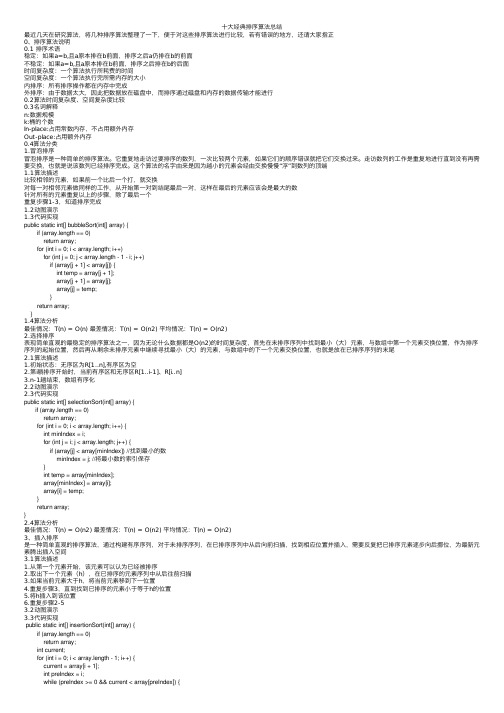
⼗⼤经典排序算法总结最近⼏天在研究算法,将⼏种排序算法整理了⼀下,便于对这些排序算法进⾏⽐较,若有错误的地⽅,还请⼤家指正0、排序算法说明0.1 排序术语稳定:如果a=b,且a原本排在b前⾯,排序之后a仍排在b的前⾯不稳定:如果a=b,且a原本排在b前⾯,排序之后排在b的后⾯时间复杂度:⼀个算法执⾏所耗费的时间空间复杂度:⼀个算法执⾏完所需内存的⼤⼩内排序:所有排序操作都在内存中完成外排序:由于数据太⼤,因此把数据放在磁盘中,⽽排序通过磁盘和内存的数据传输才能进⾏0.2算法时间复杂度、空间复杂度⽐较0.3名词解释n:数据规模k:桶的个数In-place:占⽤常数内存,不占⽤额外内存Out-place:占⽤额外内存0.4算法分类1.冒泡排序冒泡排序是⼀种简单的排序算法。
它重复地⾛访过要排序的数列,⼀次⽐较两个元素,如果它们的顺序错误就把它们交换过来。
⾛访数列的⼯作是重复地进⾏直到没有再需要交换,也就是说该数列已经排序完成。
这个算法的名字由来是因为越⼩的元素会经由交换慢慢“浮”到数列的顶端1.1算法描述⽐较相邻的元素,如果前⼀个⽐后⼀个打,就交换对每⼀对相邻元素做同样的⼯作,从开始第⼀对到结尾最后⼀对,这样在最后的元素应该会是最⼤的数针对所有的元素重复以上的步骤,除了最后⼀个重复步骤1-3,知道排序完成1.2动图演⽰1.3代码实现public static int[] bubbleSort(int[] array) {if (array.length == 0)return array;for (int i = 0; i < array.length; i++)for (int j = 0; j < array.length - 1 - i; j++)if (array[j + 1] < array[j]) {int temp = array[j + 1];array[j + 1] = array[j];array[j] = temp;}return array;}1.4算法分析最佳情况:T(n) = O(n) 最差情况:T(n) = O(n2) 平均情况:T(n) = O(n2)2.选择排序表现简单直观的最稳定的排序算法之⼀,因为⽆论什么数据都是O(n2)的时间复杂度,⾸先在未排序序列中找到最⼩(⼤)元素,与数组中第⼀个元素交换位置,作为排序序列的起始位置,然后再从剩余未排序元素中继续寻找最⼩(⼤)的元素,与数组中的下⼀个元素交换位置,也就是放在已排序序列的末尾2.1算法描述1.初始状态:⽆序区为R[1..n],有序区为空2.第i躺排序开始时,当前有序区和⽆序区R[1..i-1]、R[i..n]3.n-1趟结束,数组有序化2.2动图演⽰2.3代码实现public static int[] selectionSort(int[] array) {if (array.length == 0)return array;for (int i = 0; i < array.length; i++) {int minIndex = i;for (int j = i; j < array.length; j++) {if (array[j] < array[minIndex]) //找到最⼩的数minIndex = j; //将最⼩数的索引保存}int temp = array[minIndex];array[minIndex] = array[i];array[i] = temp;}return array;}2.4算法分析最佳情况:T(n) = O(n2) 最差情况:T(n) = O(n2) 平均情况:T(n) = O(n2)3、插⼊排序是⼀种简单直观的排序算法,通过构建有序序列,对于未排序序列,在已排序序列中从后向前扫描,找到相应位置并插⼊,需要反复把已排序元素逐步向后挪位,为最新元素腾出插⼊空间3.1算法描述1.从第⼀个元素开始,该元素可以认为已经被排序2.取出下⼀个元素(h),在已排序的元素序列中从后往前扫描3.如果当前元素⼤于h,将当前元素移到下⼀位置4.重复步骤3,直到找到已排序的元素⼩于等于h的位置5.将h插⼊到该位置6.重复步骤2-53.2动图演⽰3.3代码实现public static int[] insertionSort(int[] array) {if (array.length == 0)return array;int current;for (int i = 0; i < array.length - 1; i++) {current = array[i + 1];int preIndex = i;while (preIndex >= 0 && current < array[preIndex]) {array[preIndex + 1] = array[preIndex];preIndex--;}array[preIndex + 1] = current;}return array;}3.4算法分析最佳情况:T(n) = O(n) 最坏情况:T(n) = O(n2) 平均情况:T(n) = O(n2)4、希尔排序是简单插⼊排序经过改进之后的⼀个更⾼效的版本,也称为缩⼩增量排序,同时该算法是冲破O(n2)的第⼀批算法之⼀。
《数据结构与算法》课程思政优秀教学案例(一等奖)

《数据结构与算法》课程思政优秀教学案例(一等奖)一、课程简介数据结构与算法是计算机科学与技术专业的核心基础课程,是一门理论与实践相结合的课程,在课程体系中处于举足轻重的地位。
课程主要介绍线性表、栈、队列、数组、树、图等常用数据结构的基本概念、操作及其典型应用及基本和经典的查找、排序算法。
通过研究数据的逻辑结构和存储结构,建立在数据结构上基本运算的正确概念,学习基本算法效率的定性和定量分析方法。
使学生熟悉数据结构在计算机科学中最基本的应用,了解数据对象的特性,学会数据组织的方法,并初步具备分析和解决现实世界问题的能力。
学完本课程后学生将基本掌握数据结构和算法的设计分析技术,提高程序设计的质量;根据所求解问题的性质选择合理的数据结构并对时间空间复杂性进行必要的控制。
二、课程内容三、案例(一)案例来源案例1:人与自然的和谐发展案例2:构建社会主义和谐社会的提出过程(二)案例点评适用范围:本案例主要适用于数据结构、思想政治等课程。
本案例是一个人与自然关系、社会主义和谐观的思考,通过结合数据结构中平衡二叉树的概念,其教学目的在于使学生对平衡的概念更清晰、准确和透彻的理解,提高学生正确认识问题、分析问题和解决问题并培养严谨对待问题的工匠精神。
思政元素:和谐价值观课程思政教学目标:(1)通过案例讨论,演示平衡二叉树调整的4种情况,让学生发现其中的变化及调整规律。
(2)加强学生对平衡概念的认识,并启发学生注重心态平衡,以及社会和谐。
相关教学经验:将专业知识与社会科学、科学精神等结合,从课程知识过渡到思政元素的过程中,如何做到过渡自然,是需要注意的地方。
课上,通过讨论对平衡的理解,使学生对平衡二叉树的概念有了更深的感悟,不仅学到了课本知识,还对人与自然和谐、国家构建和谐社会有了进一步认识。
数据结构与算法试题
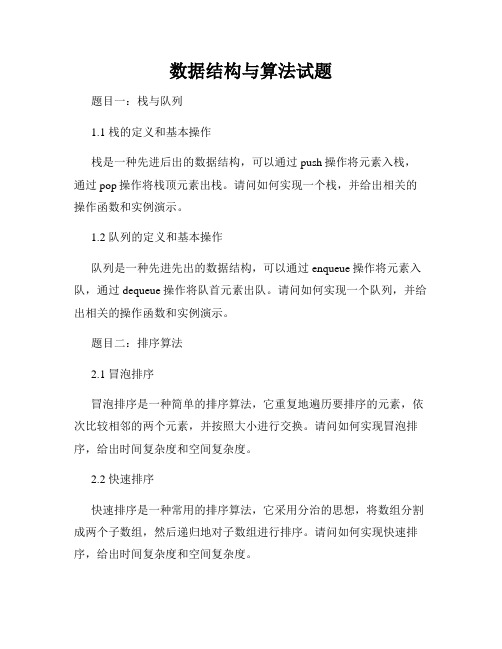
数据结构与算法试题题目一:栈与队列1.1 栈的定义和基本操作栈是一种先进后出的数据结构,可以通过push操作将元素入栈,通过pop操作将栈顶元素出栈。
请问如何实现一个栈,并给出相关的操作函数和实例演示。
1.2 队列的定义和基本操作队列是一种先进先出的数据结构,可以通过enqueue操作将元素入队,通过dequeue操作将队首元素出队。
请问如何实现一个队列,并给出相关的操作函数和实例演示。
题目二:排序算法2.1 冒泡排序冒泡排序是一种简单的排序算法,它重复地遍历要排序的元素,依次比较相邻的两个元素,并按照大小进行交换。
请问如何实现冒泡排序,给出时间复杂度和空间复杂度。
2.2 快速排序快速排序是一种常用的排序算法,它采用分治的思想,将数组分割成两个子数组,然后递归地对子数组进行排序。
请问如何实现快速排序,给出时间复杂度和空间复杂度。
题目三:查找算法3.1 二分查找二分查找是一种常见的查找算法,它要求查找的序列是有序的。
请问如何实现二分查找,给出时间复杂度和空间复杂度。
3.2 哈希表查找哈希表是一种高效的查找数据结构,通过将关键字映射到特定的位置来进行查找。
请问如何实现哈希表查找,给出时间复杂度和空间复杂度。
题目四:图算法4.1 图的定义和表示图是由节点和边构成的一种数据结构,可以用邻接矩阵或邻接表来表示。
请问如何定义和表示一个图,给出相关的数据结构和实例演示。
4.2 深度优先搜索和广度优先搜索深度优先搜索和广度优先搜索是常用的图算法,用于遍历图中的所有节点。
请问如何实现深度优先搜索和广度优先搜索,给出相应的算法和实例演示。
总结:在本文中,我们介绍了数据结构与算法中的一些常见题目,包括栈与队列、排序算法、查找算法以及图算法。
我们讨论了它们的定义、基本操作、实现方法以及相应的时间复杂度和空间复杂度。
这些内容对于理解和掌握数据结构与算法有着重要的意义,希望能够对读者有所帮助。
数据结构与算法 经典书籍

数据结构与算法经典书籍1. 《算法导论》《算法导论》是计算机科学领域中经典的教材,由Thomas H. Cormen等人合著。
该书详细介绍了各种常用的数据结构和算法,包括排序、查找、图算法等。
它以清晰的语言和丰富的实例展示了算法的设计和分析方法,对于理解和掌握算法设计与分析的基本原理具有重要意义。
2. 《数据结构与算法分析:C++语言描述》该书由Mark Allen Weiss编写,是一本介绍数据结构和算法的经典教材。
它以C++语言为基础,详细讲解了各种常用的数据结构(如链表、栈、队列、树、图等)和算法(如排序、查找、图算法等),并给出了具体的代码实现。
同时,该书还重点讲解了算法的分析和性能评估,帮助读者理解算法的时间复杂度和空间复杂度。
3. 《算法》《算法》是Sedgewick和Wayne合著的一本数据结构和算法教材。
该书系统地介绍了各种常用的数据结构和算法,并通过大量的示例和习题帮助读者巩固所学知识。
它涵盖了排序、查找、图算法等领域,并提供了Java和C++两种语言实现的代码。
这本书以其简洁明了的风格和深入浅出的讲解方法,深受学生和专业人士的喜爱。
4. 《编程珠玑》《编程珠玑》是Jon Bentley所著的一本经典之作,介绍了一系列有关程序设计和算法的问题及解决方法。
该书通过实际问题的分析和解决过程,展示了一种高效的编程思维方式。
它以具体的案例引入问题,然后通过分析和优化算法,给出了高效的解决方案。
这本书不仅适合程序员和软件工程师,也对于对算法和数据结构感兴趣的读者具有很高的参考价值。
5. 《数据结构与算法分析:Java语言描述》该书由Mark Allen Weiss编写,是一本使用Java语言描述的数据结构和算法教材。
它以清晰的语言和丰富的实例介绍了各种常用的数据结构和算法,并给出了具体的代码实现。
同时,该书还讲解了算法的分析和性能评估,帮助读者理解算法的时间复杂度和空间复杂度。
6. 《剑指Offer:名企面试官精讲典型编程题》《剑指Offer》是一本专注于面试编程题的书籍,该书由左程云所著。
《数据结构c语言》车厢调度问题解析(经典递归)

车厢调度问题解析(经典递归)博客分类:zhanghonglun算法算法题目假设停在铁路调度站入口处的车厢系列的编号依次为1,2,3,…n。
设计一个程序,求出所有可能由此输出的长度为n 的车厢系列。
解析:一个数的进栈以后,有两种处理方式:要么立刻出栈,或者下一个数的进栈(如果还有下一个元素)其出栈以后,也有两种处理方式:要么继续出栈(栈不为空),或者下一个数的入栈。
该问题有天然的递归性质算法设计:两重递归,下一个元素处理完后返回,再处理出栈的递归,有点像嵌套循环,但比它复杂...进栈的递归跳出条件为最后一个元素进栈出栈的递归跳出条件为栈空附上经典实现代码C代码1.#include<stdafx.h>2.#include<stdio.h>3.#define MaxLen 1004.struct snode{5. int data[MaxLen];6. int top;7.}s;//定义一个栈指针8.int n;//定义输入序列总个数9.void Initstack()10.{11. s.top=-1;12.}13.void push(int q)//元素n进栈14.{15. s.top++;16. s.data[s.top]=q;17.}18.int pop()//出栈19.{20. int temp;21. temp=s.data[s.top];22. s.top--;23. return temp;24.}25.int Emptys()//判断栈空26.{27. if(s.top==-1)28. return 1;29. else30. return 0;31.}32./*33.每次调用求值阶段包含两重递归,只有全部返回,才表示本pos 处理完,可以对上一个元素求值,process 就是找出当前元素进栈后所有可能的操作,即在当前元素进栈后各种情况下,34.包括不出栈,立即出栈,出栈后继续出栈情况(出栈递归)下,继续处理下一个元素(入栈递归)35.36.*/37.void process(int pos,int path[],int curp)//当前处理位置pos的元素38.{39. int m,i;40. if(pos<n)//编号进栈递归41. {42. push(pos+1);//当前元素进栈后下一个元素继续进栈43. process(pos+1,path,curp); //处理下一个元素,返回表明下一个元素进栈的情况处理完了44. pop(); //下一个元素处理完后,pop 掉,准备处理直接出栈45. }46.47. if(!Emptys())//递归处理出栈48. {49. m=pop();50. path[curp]=m;51. curp++;52. process(pos,path,curp);//出栈后处理下一个素继续进栈53. push(m);54. }55. if(pos==n&&Emptys())//输出一种可能的方案56. {57. for(i=0;i<curp;i++)58. printf("%2d",path[i]);59. printf("\n");60. }61.}62.void main()63.{64. int path[MaxLen];65. printf("输入要调度车厢总数:");66. scanf("%d",&n);67. Initstack();68. push(1);69. printf("所有输出序列:\n");70. process(1,path,0); //从1 开始,递归处理所有元素71.}。
十大经典排序算法(动图演示)
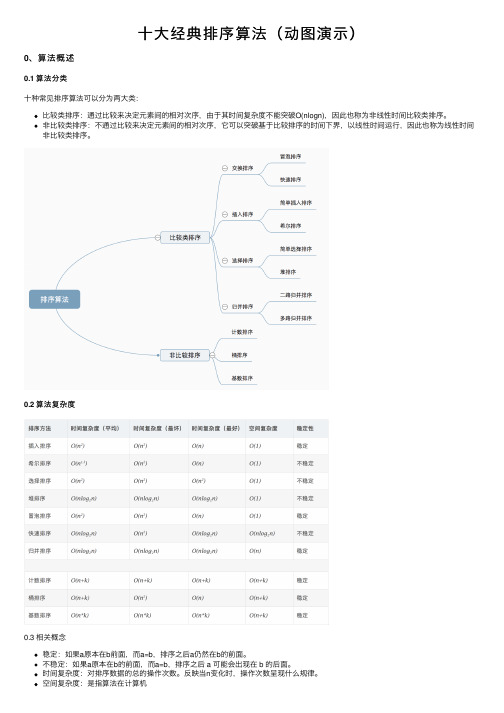
⼗⼤经典排序算法(动图演⽰)0、算法概述0.1 算法分类⼗种常见排序算法可以分为两⼤类:⽐较类排序:通过⽐较来决定元素间的相对次序,由于其时间复杂度不能突破O(nlogn),因此也称为⾮线性时间⽐较类排序。
⾮⽐较类排序:不通过⽐较来决定元素间的相对次序,它可以突破基于⽐较排序的时间下界,以线性时间运⾏,因此也称为线性时间⾮⽐较类排序。
0.2 算法复杂度0.3 相关概念稳定:如果a原本在b前⾯,⽽a=b,排序之后a仍然在b的前⾯。
不稳定:如果a原本在b的前⾯,⽽a=b,排序之后 a 可能会出现在 b 的后⾯。
时间复杂度:对排序数据的总的操作次数。
反映当n变化时,操作次数呈现什么规律。
空间复杂度:是指算法在计算机内执⾏时所需存储空间的度量,它也是数据规模n的函数。
1、冒泡排序(Bubble Sort)冒泡排序是⼀种简单的排序算法。
它重复地⾛访过要排序的数列,⼀次⽐较两个元素,如果它们的顺序错误就把它们交换过来。
⾛访数列的⼯作是重复地进⾏直到没有再需要交换,也就是说该数列已经排序完成。
这个算法的名字由来是因为越⼩的元素会经由交换慢慢“浮”到数列的顶端。
1.1 算法描述⽐较相邻的元素。
如果第⼀个⽐第⼆个⼤,就交换它们两个;对每⼀对相邻元素作同样的⼯作,从开始第⼀对到结尾的最后⼀对,这样在最后的元素应该会是最⼤的数;针对所有的元素重复以上的步骤,除了最后⼀个;重复步骤1~3,直到排序完成。
1.2 动图演⽰1.3 代码实现function bubbleSort(arr) {var len = arr.length;for (var i = 0; i < len - 1; i++) {for (var j = 0; j < len - 1 - i; j++) {if (arr[j] > arr[j+1]) { // 相邻元素两两对⽐var temp = arr[j+1]; // 元素交换arr[j+1] = arr[j];arr[j] = temp;}}}return arr;}2、选择排序(Selection Sort)选择排序(Selection-sort)是⼀种简单直观的排序算法。
数据结构经典算法

数据结构经典算法
1. 排序算法:冒泡排序、插入排序、快速排序、归并排序等。
2. 树算法:二叉树遍历、二叉搜索树、平衡树、红黑树、堆等。
3. 图算法:DFS(深度优先搜索)、BFS(广度优先搜索)、拓扑排序、最短路径、最小生成树等。
4. 字符串匹配算法:朴素算法、KMP算法、Boyer-Moore算法、Rabin-Karp 算法等。
5. 动态规划算法:背包问题、最长公共子序列、最短编辑距离等。
6. 搜索算法:迭代加深搜索、A*算法、IDA*算法等。
7. 并查集算法:用于处理集合合并和划分问题。
8. 哈希算法:用于在大量数据中快速查找和插入数据。
9. 贪心算法:背包问题、活动安排问题、最小生成树等。
10. 分治算法:归并排序、快速排序、最近点对等。
数据结构常考的5个算法
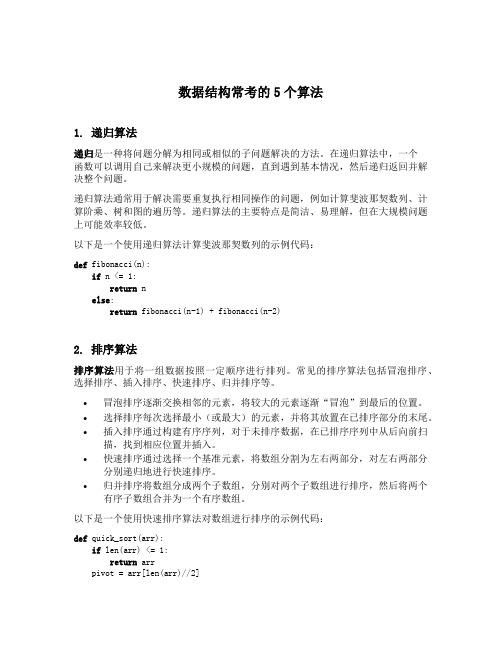
数据结构常考的5个算法1. 递归算法递归是一种将问题分解为相同或相似的子问题解决的方法。
在递归算法中,一个函数可以调用自己来解决更小规模的问题,直到遇到基本情况,然后递归返回并解决整个问题。
递归算法通常用于解决需要重复执行相同操作的问题,例如计算斐波那契数列、计算阶乘、树和图的遍历等。
递归算法的主要特点是简洁、易理解,但在大规模问题上可能效率较低。
以下是一个使用递归算法计算斐波那契数列的示例代码:def fibonacci(n):if n <= 1:return nelse:return fibonacci(n-1) + fibonacci(n-2)2. 排序算法排序算法用于将一组数据按照一定顺序进行排列。
常见的排序算法包括冒泡排序、选择排序、插入排序、快速排序、归并排序等。
•冒泡排序逐渐交换相邻的元素,将较大的元素逐渐“冒泡”到最后的位置。
•选择排序每次选择最小(或最大)的元素,并将其放置在已排序部分的末尾。
•插入排序通过构建有序序列,对于未排序数据,在已排序序列中从后向前扫描,找到相应位置并插入。
•快速排序通过选择一个基准元素,将数组分割为左右两部分,对左右两部分分别递归地进行快速排序。
•归并排序将数组分成两个子数组,分别对两个子数组进行排序,然后将两个有序子数组合并为一个有序数组。
以下是一个使用快速排序算法对数组进行排序的示例代码:def quick_sort(arr):if len(arr) <= 1:return arrpivot = arr[len(arr)//2]left = [x for x in arr if x < pivot]middle = [x for x in arr if x == pivot]right = [x for x in arr if x > pivot]return quick_sort(left) + middle + quick_sort(right)3. 查找算法查找算法用于在数据集合中查找特定元素的位置或存在性。
数据结构与算法(12):排序
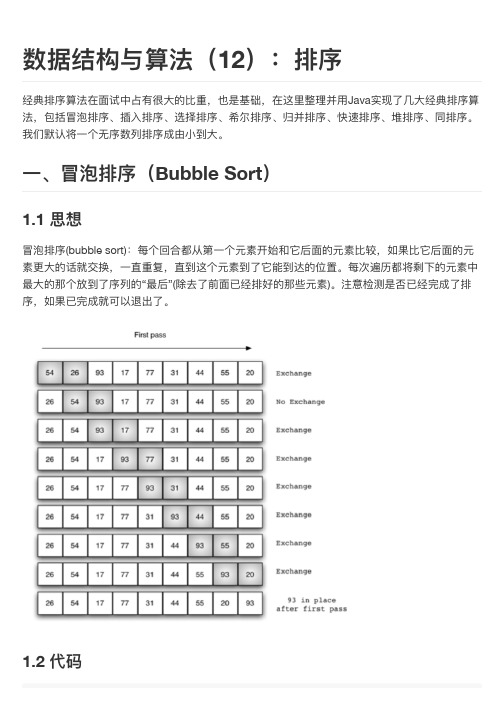
int[] data = new int[] {10,30,20,60,40,50};
mergesort(data);
for(int i:data) {
System.out.println(i);
}
}
public static void mergesort(int[] arr){
sort(arr, 0, arr.length-1);
例例如,假设有这样一一组数[ 13 14 94 33 82 25 59 94 65 23 45 27 73 25 39 10 ],如果我们以步⻓长 为5开始进行行行排序,我们可以通过将这列列表放在有5列列的表中来更更好地描述算法,这样他们就应该 看起来是这样:
13 14 94 33 82 25 59 94 65 23 45 27 73 25 39 10
坏的情况下,移动次数为n(n − 1)/2
冒泡排序的时间复杂度为O(n2)。冒泡排序不不需要辅助存储单元,其空间复杂度为O(1)。如果关
键字相等,则冒泡排序不不交换数据元素,他是一一种稳定的排序方方法。
时间复杂度:最好O(n);最坏O(n2);平均O(n2) 空间复杂度:O(1)
稳定性:稳定
二二、选择排序(Selection Sort)
排好序时,元素的移动次数为0。当每一一趟都需要移动数据元素时,总的移动次数为n − 1
选择排序的时间复杂度为O(n2)。选择排序不不需要辅助的存储单元,其空间复杂度为O(1)。选择
排序在排序过程中需要在不不相邻的数据元素之间进行行行交换,它是一一种不不稳定的排序方方法。
时间复杂度:O(n2) 空间复杂度:O(1)
地方方增量量和差值都是delta temp = arr[j-delta]; arr[j-delta] = arr[j]; arr[j] = temp;
数据结构(公式及要点汇总)

数据结构(公式及要点汇总)数据结构(公式及要点汇总)在计算机科学中,数据结构是指一种组织数据的方式。
它涉及到各种算法和操作,以及与之相关的存储结构。
数据结构对于解决实际问题非常重要,因为它可以帮助我们高效地存储和访问数据。
下面是一些常见的数据结构及其相关要点和公式的汇总:一、数组(Array)- 数组是一种线性数据结构,用于存储相同类型的元素。
- 数组的长度在创建时确定,并且在运行时不能更改。
- 元素可以通过索引访问,索引从0开始。
- 相关公式:1. 访问元素:arr[i]2. 插入元素:arr[index] = value3. 删除元素:arr[index] = null二、链表(Linked List)- 链表也是一种线性数据结构,但与数组不同,它的元素没有连续的存储空间。
- 每个元素包含数据和指向下一个元素的指针。
- 相关公式:1. 访问元素:node.value2. 插入元素:newNode.next = currentNode.next; currentNode.next = newNode3. 删除元素:prevNode.next = currentNode.next三、栈(Stack)- 栈是一种后进先出(LIFO)的数据结构。
- 只允许在栈的顶部进行插入和删除操作。
- 相关公式:1. 入栈:push(element)2. 出栈:pop()3. 取栈顶元素:top()四、队列(Queue)- 队列是一种先进先出(FIFO)的数据结构。
- 只允许在队列的一端插入元素(入队列),在另一端删除元素(出队列)。
- 相关公式:1. 入队列:enqueue(element)2. 出队列:dequeue()3. 取队首元素:front()五、树(Tree)- 树是一种非线性数据结构,由节点和边组成。
- 每个节点可以有零个或多个子节点。
- 相关公式:1. 遍历方式:前序遍历、中序遍历、后序遍历2. 计算节点数:countNodes(node)3. 计算树的高度:height(node)六、图(Graph)- 图是一种由节点和边组成的非线性数据结构。
数据结构——排序——8种常用排序算法稳定性分析
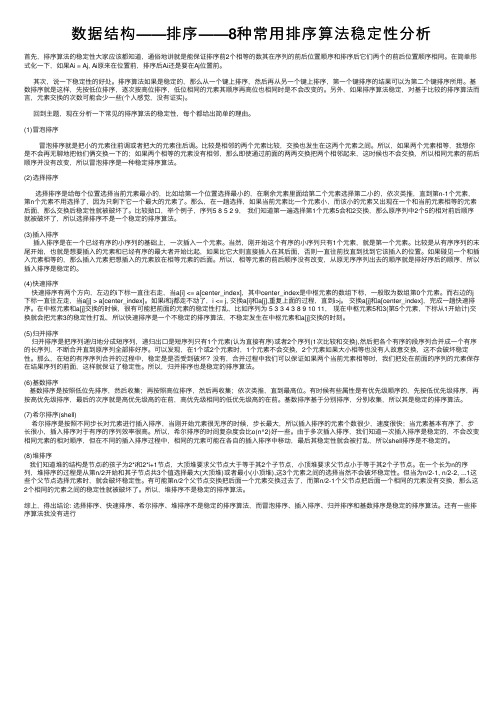
数据结构——排序——8种常⽤排序算法稳定性分析⾸先,排序算法的稳定性⼤家应该都知道,通俗地讲就是能保证排序前2个相等的数其在序列的前后位置顺序和排序后它们两个的前后位置顺序相同。
在简单形式化⼀下,如果Ai = Aj, Ai原来在位置前,排序后Ai还是要在Aj位置前。
其次,说⼀下稳定性的好处。
排序算法如果是稳定的,那么从⼀个键上排序,然后再从另⼀个键上排序,第⼀个键排序的结果可以为第⼆个键排序所⽤。
基数排序就是这样,先按低位排序,逐次按⾼位排序,低位相同的元素其顺序再⾼位也相同时是不会改变的。
另外,如果排序算法稳定,对基于⽐较的排序算法⽽⾔,元素交换的次数可能会少⼀些(个⼈感觉,没有证实)。
回到主题,现在分析⼀下常见的排序算法的稳定性,每个都给出简单的理由。
(1)冒泡排序冒泡排序就是把⼩的元素往前调或者把⼤的元素往后调。
⽐较是相邻的两个元素⽐较,交换也发⽣在这两个元素之间。
所以,如果两个元素相等,我想你是不会再⽆聊地把他们俩交换⼀下的;如果两个相等的元素没有相邻,那么即使通过前⾯的两两交换把两个相邻起来,这时候也不会交换,所以相同元素的前后顺序并没有改变,所以冒泡排序是⼀种稳定排序算法。
(2)选择排序选择排序是给每个位置选择当前元素最⼩的,⽐如给第⼀个位置选择最⼩的,在剩余元素⾥⾯给第⼆个元素选择第⼆⼩的,依次类推,直到第n-1个元素,第n个元素不⽤选择了,因为只剩下它⼀个最⼤的元素了。
那么,在⼀趟选择,如果当前元素⽐⼀个元素⼩,⽽该⼩的元素⼜出现在⼀个和当前元素相等的元素后⾯,那么交换后稳定性就被破坏了。
⽐较拗⼝,举个例⼦,序列5 8 5 2 9,我们知道第⼀遍选择第1个元素5会和2交换,那么原序列中2个5的相对前后顺序就被破坏了,所以选择排序不是⼀个稳定的排序算法。
(3)插⼊排序插⼊排序是在⼀个已经有序的⼩序列的基础上,⼀次插⼊⼀个元素。
当然,刚开始这个有序的⼩序列只有1个元素,就是第⼀个元素。
六大经典算法

六大经典算法经典算法是计算机科学中非常重要的一部分,它们被广泛应用于各种领域,包括数据结构、排序、搜索、图论和机器学习等。
下面我将介绍六大经典算法,分别是:冒泡排序、快速排序、插入排序、选择排序、归并排序和二分查找。
一、冒泡排序冒泡排序是一种简单的排序算法,它重复地遍历要排序的列表,比较相邻的元素,并按照大小顺序交换它们。
通过多次遍历,将最大的元素逐渐“冒泡”到列表的末尾,直到整个列表有序为止。
二、快速排序快速排序是一种高效的排序算法,它采用分治的思想,将一个待排序的列表不断划分为两个子列表,然后分别对子列表进行排序,最后将排序好的子列表合并起来。
快速排序的关键在于选择一个基准元素,并根据基准元素将列表划分为左右两个子列表,然后递归地对子列表进行排序。
三、插入排序插入排序是一种简单直观的排序算法,它的工作原理是将一个元素插入到已排序的列表中的适当位置,从而得到一个新的有序列表。
插入排序的核心思想是将待排序的列表分为已排序和未排序两部分,然后依次将未排序部分的元素插入到已排序部分中。
四、选择排序选择排序是一种简单的排序算法,它每次从待排序的列表中选择最小(或最大)的元素,然后将其放到已排序的列表的末尾。
通过多次选择最小(或最大)元素,选择排序可以得到一个有序的列表。
五、归并排序归并排序是一种高效的排序算法,它采用分治的思想,将一个待排序的列表递归地划分为两个子列表,然后分别对子列表进行排序,最后将排序好的子列表合并起来。
归并排序的关键在于将两个有序的子列表合并成一个有序的列表。
六、二分查找二分查找是一种高效的查找算法,它适用于有序列表。
二分查找的核心思想是不断地将待查找的区间分为两部分,然后根据目标值与中间值的大小关系,确定接下来要查找的区间,直到找到目标值或查找区间为空。
总结:以上六大经典算法分别是冒泡排序、快速排序、插入排序、选择排序、归并排序和二分查找。
这些算法在计算机科学中具有重要的地位,它们不仅可以用来解决排序和查找问题,还可以应用于其他领域,如图论、机器学习等。
数据结构和算法部分经典例子

数据结构和算法部分经典例子一、迭代法迭代法是用于求方程或方程组近似根的一种常用的算法设计方法。
设方程为f(x)=0,用某种数学方法导出等价的形式x=g(x),然后按以下步骤执行:(1)选一个方程的近似根,赋给变量x0;(2)将x0的值保存于变量x1,然后计算g(x1),并将结果存于变量x0;(3)当x0与x1的差的绝对值还小于指定的精度要求时,重复步骤(2)的计算。
若方程有根,并且用上述方法计算出来的近似根序列收敛,则按上述方法求得的x0就认为是方程的根。
上述算法用C程序的形式表示为:【算法】迭代法求方程的根{ x0=初始近似根;do {x1=x0;x0=g(x1);/*按特定的方程计算新的近似根*/} while ( fabs(x0-x1)>Epsilon);printf(“方程的近似根是%f\n”,x0);}迭代算法也常用于求方程组的根,令X=(x0,x1,…,xn-1)设方程组为:xi=gi(X) (I=0,1,…,n-1)则求方程组根的迭代算法可描述如下:【算法】迭代法求方程组的根{ for (i=0;i<n;i++)x[i]=初始近似根;do {for (i=0;i<n;i++)y[i]=x[i];for (i=0;i<n;i++)x[i]=gi(X);for (delta=0.0,i=0;i<n;i++)if (fabs(y[i]-x[i])>delta) delta=fabs(y[i]-x[i]);} while (delta>Epsilon);for (i=0;i<n;i++)printf(“变量x[%d]的近似根是%f”,I,x[i]);printf(“\n”);}具体使用迭代法求根时应注意以下两种可能发生的情况:(1)如果方程无解,算法求出的近似根序列就不会收敛,迭代过程会变成死循环,因此在使用迭代算法前应先考察方程是否有解,并在程序中对迭代的次数给予限制;(2)方程虽然有解,但迭代公式选择不当,或迭代的初始近似根选择不合理,也会导致迭代失败。
头歌数据结构十大经典排序算法
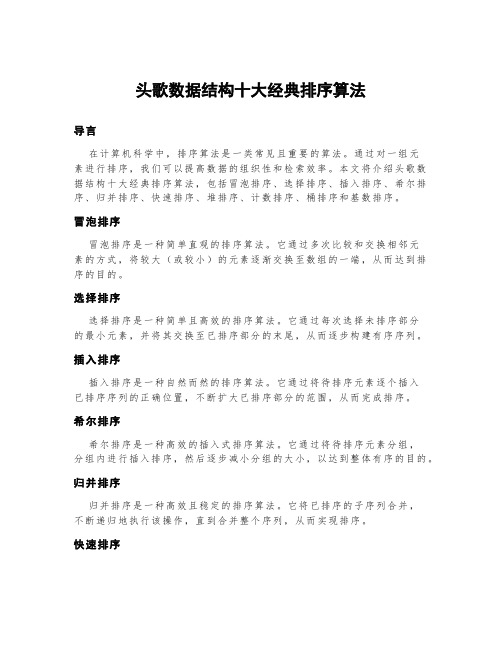
头歌数据结构十大经典排序算法导言在计算机科学中,排序算法是一类常见且重要的算法。
通过对一组元素进行排序,我们可以提高数据的组织性和检索效率。
本文将介绍头歌数据结构十大经典排序算法,包括冒泡排序、选择排序、插入排序、希尔排序、归并排序、快速排序、堆排序、计数排序、桶排序和基数排序。
冒泡排序冒泡排序是一种简单直观的排序算法。
它通过多次比较和交换相邻元素的方式,将较大(或较小)的元素逐渐交换至数组的一端,从而达到排序的目的。
选择排序选择排序是一种简单且高效的排序算法。
它通过每次选择未排序部分的最小元素,并将其交换至已排序部分的末尾,从而逐步构建有序序列。
插入排序插入排序是一种自然而然的排序算法。
它通过将待排序元素逐个插入已排序序列的正确位置,不断扩大已排序部分的范围,从而完成排序。
希尔排序希尔排序是一种高效的插入式排序算法。
它通过将待排序元素分组,分组内进行插入排序,然后逐步减小分组的大小,以达到整体有序的目的。
归并排序归并排序是一种高效且稳定的排序算法。
它将已排序的子序列合并,不断递归地执行该操作,直到合并整个序列,从而实现排序。
快速排序快速排序是一种高效的分治排序算法。
它通过选择一个基准元素,将序列分割成两部分,并分别对这两部分进行排序,最终将序列有序地整合起来。
堆排序堆排序是一种高效且稳定的排序算法。
它利用堆这种特殊的数据结构,在每次构建堆过程中,获取最大(或最小)元素,并将其放入已排序部分的末尾,从而完成排序。
计数排序计数排序是一种非比较性的排序算法。
它通过统计每个元素出现的次数,计算每个元素应该在有序序列中的位置,从而完成排序。
桶排序桶排序是一种高效的排序算法。
它通过将元素分配到不同的桶中,并对每个桶进行排序,从而得到排序结果。
基数排序基数排序是一种高效的排序算法。
它通过将待排序元素按照个位、十位、百位等进行排序,最终得到有序序列。
结语头歌数据结构十大经典排序算法是计算机科学中不可或缺的内容。
数据结构八大排序之冒泡排序算法

数据结构八大排序之冒泡排序算法冒泡排序是一种经典的排序算法,它基于比较和交换的思想,简单易懂却非常高效。
在实际应用中,我们经常会遇到需要对一组数据进行排序的情况,而冒泡排序就是解决这个问题的利器。
首先,我们来了解一下冒泡排序的基本原理。
冒泡排序的核心思想是通过相邻元素的比较和交换,将较大的元素逐渐“冒泡”到数组的末尾,达到排序的目的。
具体来说,算法从数组的第一个元素开始,比较相邻的两个元素,如果前一个元素大于后一个元素,则交换它们的位置;如果前一个元素小于等于后一个元素,则位置不变。
通过一轮比较后,最大的元素就会“冒泡”到数组的末尾。
然后,算法再从数组的第一个元素开始进行下一轮比较,依次类推,直到所有元素都排好序。
接下来,我们详细了解冒泡排序的具体步骤。
假设我们需要对一个由n个元素组成的数组进行排序,首先,我们需要进行n-1轮的比较。
每一轮比较都从数组的第一个元素开始,比较相邻的两个元素,根据大小进行交换或保持不变。
一轮比较下来,最大的元素就会“冒泡”到数组的末尾。
然后,下一轮比较就会从数组的第一个元素到倒数第二个元素进行,以此类推,直到最后一轮只需要比较数组的前两个元素。
冒泡排序的时间复杂度为O(n²),这是因为每一轮比较需要遍历整个数组,而总共需要进行n-1轮比较。
在最好的情况下,也就是数组已经排好序的情况下,冒泡排序的时间复杂度可以优化到O(n)。
然而,在最坏的情况下,即数组完全逆序的情况下,冒泡排序的性能较差。
冒泡排序是一种稳定的排序算法,这意味着相等元素的相对顺序不会被改变。
冒泡排序的思想简单直观,实现也相对简单,所以它在教学和入门级应用中被广泛使用。
然而,在大规模数据的排序中,由于其时间复杂度较高,冒泡排序的效率相对较低。
除了基本的冒泡排序算法,还有一些优化的方法可以进一步提高算法的效率。
例如,我们可以设置一个标志位来判断一轮比较中是否进行了交换,如果没有交换,说明数组已经有序,可以提前结束排序。
数据结构之——八大排序算法

数据结构之——⼋⼤排序算法排序算法⼩汇总 冒泡排序⼀般将前⾯作为有序区(初始⽆元素),后⾯作为⽆序区(初始元素都在⽆序区⾥),在遍历过程中把当前⽆序区最⼩的数像泡泡⼀样,让其往上飘,然后在⽆序区继续执⾏此操作,直到⽆序区不再有元素。
这块是对⽼式冒泡排序的⼀种优化,因为当某次冒泡结束后,可能数组已经变得有序,继续进⾏冒泡排序会增加很多⽆⽤的⽐较次数,提⾼时间复杂度。
所以我们增加了⼀个标识变量flag,将其初始化为1,外层循环还是和⽼式的⼀样从0到末尾,内存循环我们改为从最后⾯向前⾯i(外层循环所处的位置)处遍历找最⼩的,如果在内存没有出现交换,说明⽆序区的元素已经变得有序,所以不需要交换,即整个数组已经变得有序。
(感谢@站在远处看童年在评论区的指正)#include<iostream>using namespace std;void sort(int k[] ,int n){int flag = 1;int temp;for(int i = 0; i < n-1 && flag; i++){flag = 0;for(int j = n-1; j > i; j--){/*下⾯这⾥和i没关系,注意看这块,从下往上travel,两两⽐较,如果不合适就调换,如果上来后⼀次都没调换,说明下⾯已经按顺序拍好了,上⾯也是按顺序排好的,所以完美!*/if(k[j-1] > k[j]){temp = k[j-1];k[j-1] = k[j];k[j] = temp;flag = 1;}}}}int main(){int k[3] = {0,9,6};sort(k,3);for(int i =0; i < 3; i++)printf("%d ",k[i]);}快速排序(Quicksort),基于分治算法思想,是对冒泡排序的⼀种改进。
快速排序由C. A. R. Hoare在1960年提出。
数据结构课程设计排序算法总结

排序算法:(1) 直接插入排序 (2) 折半插入排序(3) 冒泡排序 (4) 简单选择排序 (5) 快速排序(6) 堆排序 (7) 归并排序【算法分析】(1)直接插入排序;它是一种最简单的排序方法,它的基本操作是将一个记录插入到已排好的序的有序表中,从而得到一个新的、记录数增加1的有序表。
(2)折半插入排序:插入排序的基本操作是在一个有序表中进行查找和插入,我们知道这个查找操作可以利用折半查找来实现,由此进行的插入排序称之为折半插入排序。
折半插入排序所需附加存储空间和直接插入相同,从时间上比较,折半插入排序仅减少了关键字间的比较次数,而记录的移动次数不变。
(3)冒泡排序:比较相邻关键字,若为逆序(非递增),则交换,最终将最大的记录放到最后一个记录的位置上,此为第一趟冒泡排序;对前n-1记录重复上操作,确定倒数第二个位置记录;……以此类推,直至的到一个递增的表。
(4)简单选择排序:通过n-i次关键字间的比较,从n-i+1个记录中选出关键字最小的记录,并和第i(1<=i<=n)个记录交换之。
(5)快速排序:它是对冒泡排序的一种改进,基本思想是,通过一趟排序将待排序的记录分割成独立的两部分,其中一部分记录的关键字均比另一部分记录的关键字小,则可分别对这两部分记录继续进行排序,以达到整个序列有序。
(6)堆排序: 使记录序列按关键字非递减有序排列,在堆排序的算法中先建一个“大顶堆”,即先选得一个关键字为最大的记录并与序列中最后一个记录交换,然后对序列中前n-1记录进行筛选,重新将它调整为一个“大顶堆”,如此反复直至排序结束。
(7)归并排序:归并的含义是将两个或两个以上的有序表组合成一个新的有序表。
假设初始序列含有n个记录,则可看成是n个有序的子序列,每个子序列的长度为1,然后两两归并,得到n/2个长度为2或1的有序子序列;再两两归并,……,如此重复,直至得到一个长度为n的有序序列为止,这种排序称为2-路归并排序。
- 1、下载文档前请自行甄别文档内容的完整性,平台不提供额外的编辑、内容补充、找答案等附加服务。
- 2、"仅部分预览"的文档,不可在线预览部分如存在完整性等问题,可反馈申请退款(可完整预览的文档不适用该条件!)。
- 3、如文档侵犯您的权益,请联系客服反馈,我们会尽快为您处理(人工客服工作时间:9:00-18:30)。
{
case 1:
{
display(p);
break;
}
case 2:
{
printf("input a push a value:\n");
scanf("%d",&h);
}
case 4:
{
x2=gettop(p);
printf("x2->%d",x2);
break;
}
}
}
�
s->top=s->top-1;
return y;
}
}
int gettop(stackstru *s) /*得到栈顶数*/
{
int e;
if(s->top==0)
return 0;
else
e=s->stack[s->top];
return e;
}
main(stackstru *p)
{
int n,i,k,h,x1,x2,select;
printf("create a empty stack!\n");
init(p);
printf("input a stack length:\n");
{
if (s->top==m)
printf("the stack is overflow!\n");
else
{
s->top=s->top+1;
s->stack[s->top]=x;
}
}
void display(stackstru *s) /*显示栈所有数据*/
printf("select 2:push()\n");
printf("select 3:pop()\n");
printf("select 4:gettop()\n");
printf("input a your select(1-4):\n");
scanf("%d",&select);
scanf("%d",&n);
for(i=0;i<n;i++)
{
printf("input a stack value:\n");
scanf("%d",&k);
push(p,k);
}
printf("select 1:display()\n");
}
}
}
int pop(stackstru *s) /*出栈操作并返回被删除的那个记录*/
{
int y;
if(s->top==0)
printf("the stack is empty!\n");
else
{
y=s->stack[s->top];
#define m 100
typedef struct
{
int stack[m];
int top;
}stackstru;
init(stackstru *s) /*装入栈*/
{
s->top=0;
return 1;
}
int push(stackstru *s,int x) /*入栈操作*/
push(p,h);
display(p);
break;
}
case 3:
{
x1=pop(p);
printf("x1->%d\n",x1);
display(p);
break;
{
if(s->top==0)
printf("the stack is empty!\n");
else
{ intf("%d->",s->stack[s->top]);
s->top=s->top-1;
